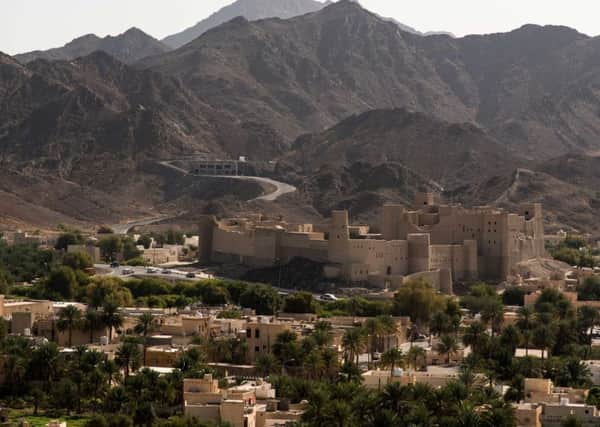Travel review: Oman - destination eco-tourism


Wrapping my leg nervously around the cornerstone of a mountain outcrop, I’m almost doing the splits to reach my next foothold. Below the vertical drop, a rugged canyon tears through charred, flaking rock, burst open like an overcooked pastry. Retreating mountain goats splay plumes of dust with their hooves and silhouettes of swallows wheel from shadowy caves.
As I complete the final section of a via ferrata at Oman’s Alila Jabal Akhdar hotel, I’m bathed in the shimmering marigold light of a setting sun – along with beads of anguished sweat.
Advertisement
Hide AdAdvertisement
Hide AdAlthough attached firmly with ropes and a carabiner hook, I’m convinced my legs will jellify and cheat me, and my head is filled with nothing but my next step.
Wild, pristine and sparsely populated, Oman is a destination ripe for adventure. Like most Middle Eastern countries thrown off kilter by the falling price of oil, tourism is becoming a new economic interest – although it’s still very much in its infancy.
Less flashy than Dubai, more progressive than Saudi Arabia, it’s the gentle Gulf state where 47 years of absolute rule has maintained peace and stability. It’s hard to imagine civil war once waged through the Al Hajar Mountains in the north of the country – although the Sultan has banned all mention in local history books.
Open in 2004, a road now winds up to the plateaus and most of the crumbling 300-year-old shepherds’ villages have been abandoned. Constructed using stone from the mountain, the design of the low-lying Alila hotel is based on one of these settlements, As Sarab. On a hiking trail to explore the ghostly ruins, only tiny geckos keep me company.
Advertisement
Hide AdAdvertisement
Hide AdOverlooking the vast chasm where the via ferrata winds around, Alila’s views are heart-stopping. The watchtowers and sandstone forts of Bahla and Nizwa hover on the far horizon, and at night, stars spray the sky silver. Sensitive to the environment, the property is partly powered by solar energy, uses its own water source and buys produce from a collective of farmers based in the mountain.
Many crops are grown on ancient terraces in the nearby UNESCO-listed Saiq Plateau, famously visited by Charles and Diana in 1986, when they flew in by helicopter for a picnic.
Now though, a clinical hotel owned by the Ministry of Defence sits on the Diana viewpoint, and over-consumption of water has led to one of the mountain springs drying up for the first time in history.
Rose farmers, whose velveteen pink petals are irrigated using a traditional stone aflaj system, have been the most affected, and finding a solution to the problem is one of the many challenges facing a rapidly modernizing Oman.
Advertisement
Hide AdAdvertisement
Hide AdVast areas of the country, such as the Empty Quarter, are inhospitable, but other desert regions have been adapted to tourism. Stretching 80km from the interior to the coast, Wahiba Sands takes just four hours to cross.
A sandstorm is brewing when we arrive at the 1000 Nights Camp, and drive to a high point to watch bolts of lightning shatter the sky until torrents of rain begin to fall – something I never thought possible in the desert.
The next morning, I awake to birdsong, and find camels happily chewing on vegetation sprouting from the dust. Lifting their heads curiously as we approach, the calm creatures gaze at us wide-eyed and wide-mouthed.
“I call that the Polo expression,” laughs my guide and driver Abdullah, dressed in the traditional dishdasha robe with a turban swept around his head.
Advertisement
Hide AdAdvertisement
Hide AdContinuing our journey, we head to the coast. Set between the Khawr al Masirah and the Arabian Sea, Masirah is Oman’s largest island and a nesting ground for loggerhead turtles. It’s still relatively undiscovered by tourists with only one major hotel, Masirah Island Resort, in the north.
During the one-hour ferry ride from Shana (3 Rial/£5 one way), I’m ushered into a single sex seating area. Typical of Masirah, women wear a silky face mask, leaving only their kohl-lined eyes visible, and many shy away from public view. In fact, this is the closest female contact I have throughout my entire stay.
Fringed by fine sand beaches backing onto a mountainous interior, Masirah is Oman in microcosm. Most visitors come in July and August when turtles are hatching, but out of season it’s oddly quiet. Standing in the glittering surf washed up from the warm Arabian Sea, I can easily imagine boutique resorts finding a happy home here.
For now, though, burrowing hermit crabs have the place to themselves. Selfishly, I hope those unpredictable deserts, treacherous mountains and wild seas will always be a little out of reach.
GETTING THERE
The Ultimate Travel Company offers tailor-ade tours to Oman.
Visit theultimatetravelcompany.com or call 020 3811 6830.